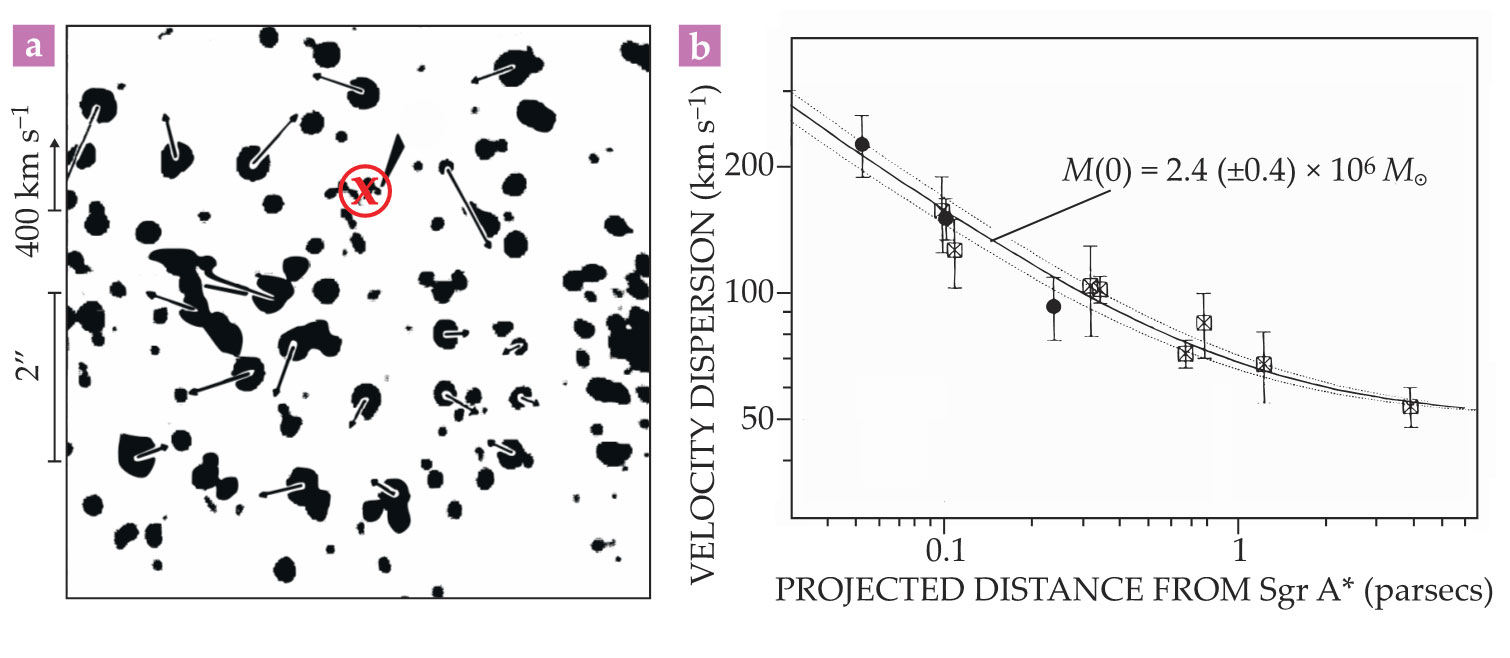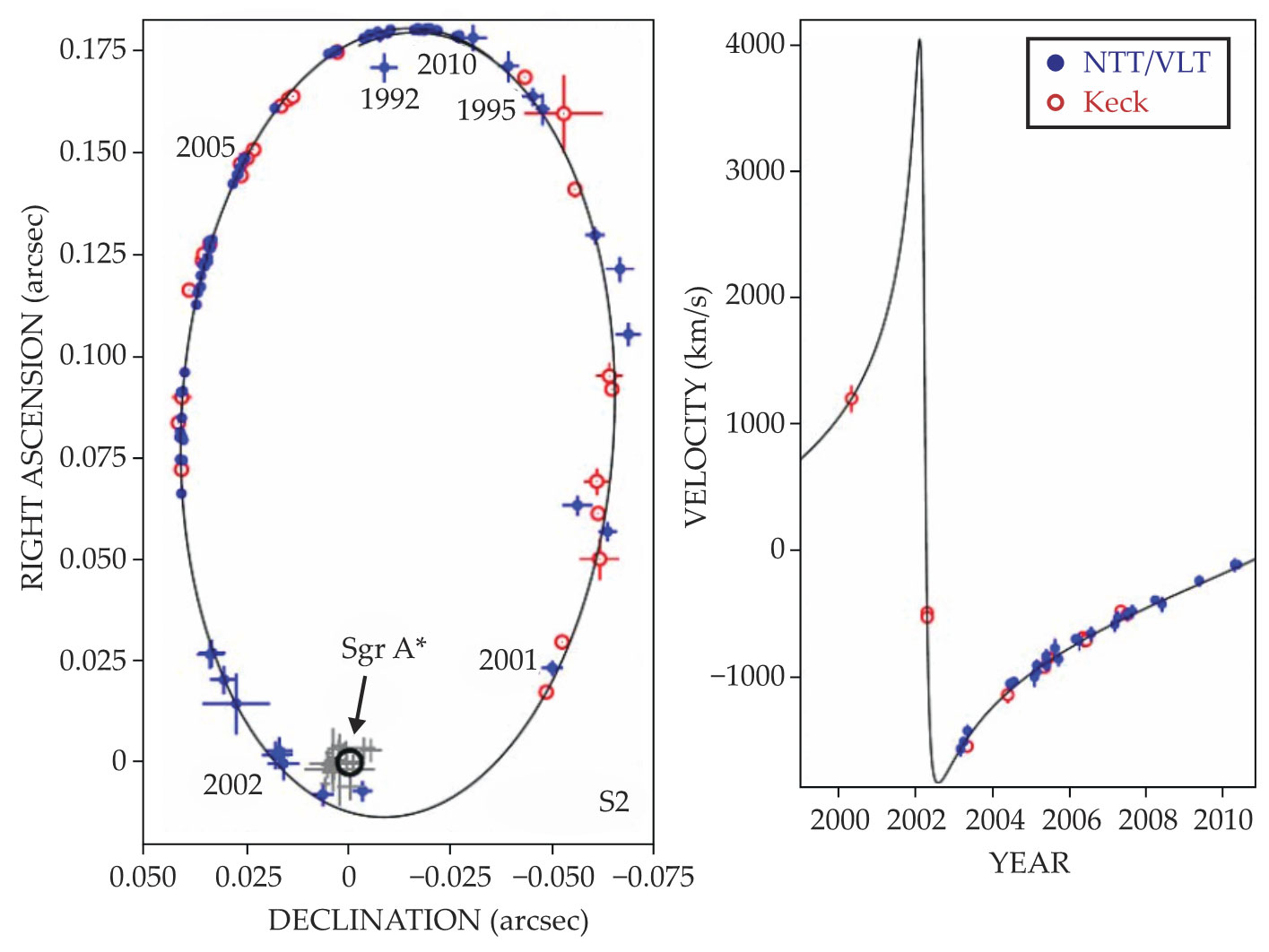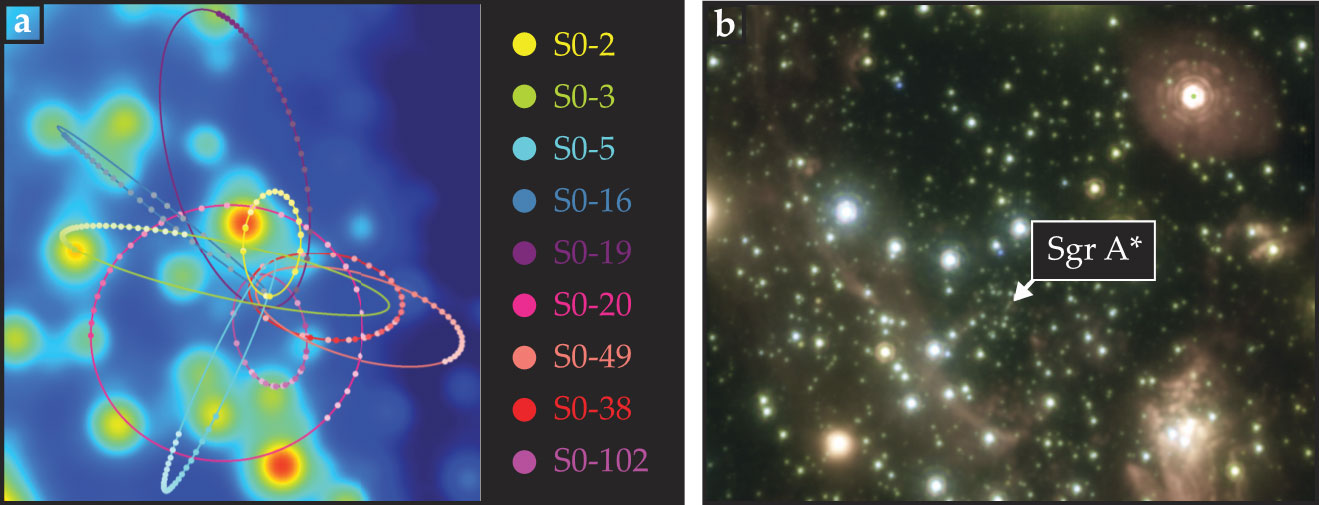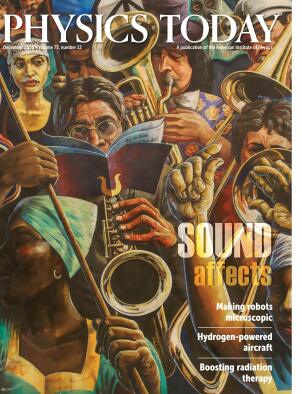Nobel Prize in Physics honors the discovery of a supermassive compact object at the heart of the Milky Way
DOI: 10.1063/PT.3.4629
When newly graduated Karl Jansky joined Bell Laboratories in 1928, his first assignment was to determine the source of static that plagued transatlantic radio transmissions. Having built a rotating antenna, he found a radio signal emanating from the center of the Milky Way, in the direction of the constellation Sagittarius. On 5 May 1933 the New York Times reported Jansky’s discovery of “star noise.” The radio source later became known as Sagittarius A.
Although Jansky (1905–50) did not live long enough to learn the implication of his discovery, those radio waves were one of the first observational forays that later revealed the black hole sitting at the galactic center. The next decades yielded theoretical and observational results that explained radio emissions coming from distant galaxies and uncovered what lies at the heart of our own galaxy.
Reinhard Genzel, Andrea Ghez, and their collaborators provided experimental evidence that pinned down the source of the radio signals. Their painstaking measurements of the orbital motions of stars near the galactic center conformed to general relativity predictions of objects swirling around a black hole. The Nobel Prize committee awarded half of this year’s physics prize to Genzel and Ghez, “for their discovery of a supermassive compact object at the center of our galaxy.” Their insights set a new course for testing subtle effects of general relativity.
Reinhard Genzel MAX PLANCK INSTITUTE FOR EXTRATERRESTRIAL PHYSICS, GARCHING Andrea Ghez CHRISTOPHER DIBBLE



It started with a quasar
Radio astronomy was in its infancy in the 1950s when astronomers were puzzled by all-sky surveys that revealed radio emissions from compact, apparently extragalactic locales with no corresponding objects in the visible. Those mysterious emissions were dubbed quasi-stellar objects, or quasars. (See the article by Hong-Yee Chiu, Physics Today, May 1964, page 21
In 1971 Donald Lynden-Bell and Martin Rees applied the black hole model of quasars to predict the spectroscopic signatures of dust and stars moving around a putative supermassive black hole at the center of the Milky Way. Their predictions inspired astronomers to look in our cosmic backyard to establish the existence of supermassive black holes.
Jansky traced radio waves to the constellation of Sagittarius in 1933, but funding shortages and office politics prevented him from further investigating their origin. It wasn’t until 1974, at the National Radio Astronomy Observatory, that Robert Brown and Bruce Balick pinpointed an even stronger and more compact source of radio emissions from the center of the Milky Way, within the source reported by Jansky, near the border of the constellations Sagittarius and Scorpius. 1 Brown named that compact radio source Sagittarius A*, or Sgr A*.
Measuring the velocities of stars and gas clouds orbiting Sgr A* would ultimately determine the mass and radius of the source. However, tools for doing so were in their infancy. Thick clouds of dust obscure the galactic center in visible light, so sensitive spectroscopy in the far-IR was needed to tease out both the chemical structure and the motion of gases swirling around Sgr A*.
“That’s where my second father, Charles Townes, comes in,” says Genzel. He joined Townes’s research group at the University of California, Berkeley, in the 1980s, where he helped to develop IR spectrometers for measuring the motions of gas clouds at different distances from Sgr A*. With those tools the researchers determined that clouds of ionized gas closer to the galactic center moved faster than those farther away, in a relationship that followed Kepler’s laws of motion.
From those velocities, Townes and Genzel calculated that the gravity fields associated with a point mass of 4 million solar masses could drive the motion of the interstellar gases. 2 Such a massive object would be consistent with a black hole. “But nobody believed us,” says Genzel. Other astronomers argued that winds or magnetic fields could also cause gases to move. Nonetheless, Genzel says, “we were fully convinced that it was a black hole.” To convince the larger astronomy community, the Berkeley team realized, would require tracking the motions of individual stars.
Star of the show
By the early 1990s, near-IR speckle imaging was the best available tool for measuring the positions of distant stars. The technique produces clear composite images of celestial objects otherwise blurred by atmospheric turbulence. It does so via many short-exposure photographs, each of which captures a snapshot of the time-varying turbulence. Then the short exposures are spatially shifted to align the pattern of stars captured and are stacked on top of each other to provide a sharper image than any individual snapshot. (See the Quick Study by Steve Howell and Elliott Horch, Physics Today, November 2018, page 78
Genzel and Ghez each focused their team’s efforts on taking speckle images of the stellar cluster surrounding the galactic center. For three years Ghez and her colleagues at UCLA used the near-IR camera at the W. M. Keck Observatory in Hawaii to trace shifts in the positions of 90 stars across the sky.
3
Genzel and his colleagues at the Max Planck Institute for Extraterrestrial Physics in Germany used the 3.5-meter New Technology Telescope at the European Southern Observatory (ESO) in Chile to trace the positions of 39 stars, some shown in figure
Both groups concluded by the late 1990s that our galaxy harbors a central dark mass of two to three million solar masses (see figure
Figure 1.

Stars move near the galactic center. (a) Vectors indicate stellar motions in the immediate vicinity of radio source Sagittarius A* (Sgr A*), denoted by the red X, as determined by a four-year survey. (b) A star’s velocity is a function of its distance from Sgr A*. Solid circles indicate the velocity dispersion estimated from stars’ proper motions, the apparent shifts in their positions. Open rectangles indicate velocity dispersion estimated from stars’ line-of-sight velocities. Curves indicate the velocity behavior expected for a single massive point source with 2.4 million M☉. (Adapted from ref.

According to Genzel, the initial stellar velocity measurements convinced astronomers that a black hole was present, but it did not convince physicists, whose skepticism originated in the reliability of far-away observations that didn’t explicitly measure orbital accelerations. Both teams understood that to fully resolve the problem, they would need direct measurements not just of changes in the stars’ positions but also of their radial velocities—that is, their motion along the observer’s line of sight. But doing so was impossible with speckle imaging. Short exposure times limited monitoring to only the brightest stars. Velocity measurements required lengthy surveys and amounted to a marathon of beating down errors.
Fortunately, says Do, “this is also when technology started really improving.” The new technology, known as adaptive optics, was first proposed in 1953. It allows Earth-bound telescopes to compensate for blurring due to atmospheric turbulence and see almost as clearly as if they were in space. The technique became available to Ghez’s team at the Keck Observatory in 2000 and to Genzel’s team at the ESO in 2003.
Adaptive optics relies on a bright, fixed reference object in the sky—either a bright known star near the observation target or an artificial star created by laser excitation of sodium atoms in the atmosphere. Sensors measure distortions in the wavefront of light a telescope receives from the reference object. Those distortion measurements enter a feedback loop that deforms a mirror in the telescope to correct for blurring. (See the article by Laird Thompson, Physics Today, December 1994, page 24
In 2002 Ghez and her colleagues completed the first measurements of an individual star, which they called S02, in the Milky Way’s central stellar cluster. 5 The researchers monitored the Doppler shifts in S02’s emission spectrum, inferred its velocity as it travelled around Sgr A*, and pinpointed the mass and the location of the object that it must be orbiting. “No assumptions other than Kepler’s laws were required to determine the black hole mass and the distance from the star to the galactic center,” says Do.
Genzel’s team made similar observations to trace the orbit of the same star, which they called simply S2. The two teams’ measurements aligned precisely with a highly elliptical orbit around a black hole of 4 million solar masses. The star approached Sgr A* at a perihelion distance of 17 light-hours. 6 “By the time a single orbit was measured, physicists took it seriously,” says Genzel.
Several more years of observations, illustrated in figure
Figure 2.

The star S2 follows an elliptical orbit around Sagittarius A*. The star’s offset from Sgr A* as seen on the sky (left) and its radial velocity (right). The blue circles indicate data from the New Technology Telescope (NTT) and Very Large Telescope (VLT); the red circles are from the Keck Observatory. The gray crosses show the positions of IR flares that have been observed near Sgr A*. The data were collected through 2010. (Adapted from ref.

Precise precessions
Knowing that S2 should repeat its closest approach of the supermassive black hole in 2018, both teams eagerly awaited the opportunity to test a key prediction of Einstein’s theory of general relativity: that an object’s elliptical orbit should rotate gradually, or precess, at a rate different from that predicted by classical Newtonian mechanics. The prediction had been confirmed only in weak gravitational fields, such as the Sun’s pull on Mercury. Testing it in a strong gravitational field became possible only with the observation of short-period stars in the galactic center. Both teams’ measurements of the precession of S2’s orbit showed that the theory does hold in strong gravitational fields. 8
It would be surprising if the precession of stellar orbits strayed from general relativity, says Scott Tremaine of the Institute for Advanced Study in Princeton, New Jersey. However, as the measurement precision improves and observational time span increases, slight deviations from relativistic precession could reveal subtle constraints on theories of gravity that have not yet been quantified. Those deviations could also provide clues about other nonluminous matter—for example, stars too faint to be seen—that lies within a star’s measured orbit. “The trick is to disentangle the effects of other stars from the effects of general relativity,” says Tremaine.
That task requires examining the orbits of other stars close to the galactic center. The data set gathered by both Genzel and Ghez revealed other stars fainter than S2 that were at times hidden behind each other, but their orbits can be partially recovered by combing through older data (figure
Figure 3.

Improved technology has brought finer-scale views of the galactic center. (a) Twenty-five years of observations have revealed the movements of many stars, including S02, within the central 1.0 × 1.0 arcseconds of the Milky Way. The annual average star positions are plotted as colored dots. Also shown are the best-fitting orbital solutions assuming a central supermassive black hole. The background is a 1.0 × 1.0 arcsec diffraction-limited image of the galactic center from 2015. (b) An image taken with the laser-guide-star adaptive-optics system at the Keck Observatory shows the central galaxy’s central 10 × 10 arcsec region. (Courtesy of Keck Observatory/UCLA Galactic Center Group.)

Emerging technologies will help. Researchers at the ESO recently developed the Very Large Telescope interferometer, which combines observations from four telescopes to generate images that have the spatial resolution equivalent to that of a 130 m telescope. Meanwhile, the Keck Observatory is planning a second-generation adaptive optics system.
Hopes and expectations
“Everything we’ve seen so far is consistent with general relativity,” says Genzel. Nevertheless, he notes, irrefutable proof that a candidate black hole is indeed a black hole requires determining values for the other specific parameters predicted by general relativity. In addition to mass, that includes the black hole’s rotation rate. According to simulations, the orbit of another star at half to a third of S2’s distance to the galactic center could provide the data necessary to calculate the spin of the proposed Milky Way black hole and its gravitational field. As the bright star S2 moves farther away from the galactic center, plotting the orbits of fainter, closer-in stars will become easier.
The view of the galactic center provided by Genzel and Ghez broadens the possibilities of answering complex questions. How does energy released during a black hole’s formation influence the development of the rest of the galaxy? At what rate do stars fall into a central black hole? How does a black hole become supermassive?
Adaptive optics have already shown a surprising number of young stars and a lack of late-type stars near Sgr A*. “It’s a hostile environment for making stars, so it stretches our understanding about star formation,” says Tremaine. If stars get close enough to be tidally disrupted, they produce flares. Their interaction with the black hole may create hypervelocity stars that escape the galaxy extremely quickly. (See the article by Warren Brown, Physics Today, June 2016, page 52
The radio-emitting object at the center of our galaxy made its debut as an intriguing source of “star noise” that interfered with terrestrial telecommunications. It now marks a region of the galaxy that can serve as an observational laboratory for exploring the impact of a supermassive black hole on stellar and interstellar environments. Shelley Wright (UC San Diego), who designs instrumentation for the Keck Observatory, says “the best physics that they’re going to learn is still to come.”
References
1. B. Balick, R. L. Brown, Astrophys. J. 194, 265 (1974). https://doi.org/10.1086/153242
2. M. K. Crawford et al., Nature 315, 467 (1985). https://doi.org/10.1038/315467a0
3. A. M. Ghez et al., Astrophys. J. 509, 678 (1998). https://doi.org/10.1086/306528
4. A. Eckart, R. Genzel, Nature 383, 415 (1996). https://doi.org/10.1038/383415a0
5. A. M. Ghez et al., Astrophys. J. Lett. 586, L127 (2003). https://doi.org/10.1086/374804
6. R. Schödel et al., Nature 419, 694 (2002). https://doi.org/10.1038/nature01121
7. R. Genzel, F. Eisenhauer, S. Gillessen, Rev. Mod. Phys. 82, 3121 (2010). https://doi.org/10.1103/RevModPhys.82.3121
8. R. Abuter et al., Astron. Astrophys. 615, L15 (2018); https://doi.org/10.1051/0004-6361/201833718
T. Do et al., Science 365, 664 (2019). https://doi.org/10.1126/science.aav8137




